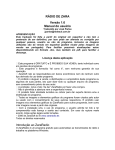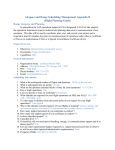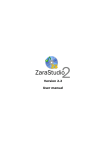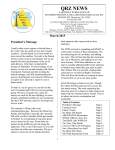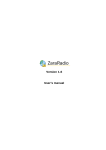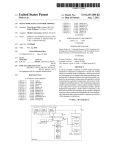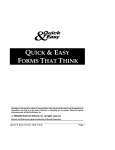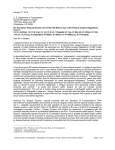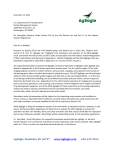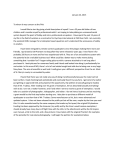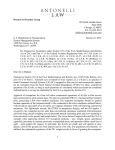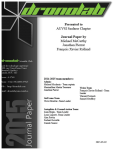Download Singer`s_Creations_-_Exemption_Rulemaking
Transcript
Singer’s Creations 4075 Linglestown Road PMB #333 Harrisburg, PA 17112 717-576-2707 [email protected] November 2, 2014 U.S. Department of Transportation, Docket Operations West Building Ground Floor, Room W12-140 1200 New Jersey Avenue, SE Washington, DC 20590 Re: Request for exemption under Section 333 from 14 CFR Part 21, Subpart H; 14 CFR 61.113 (a) and (b); 14 CFR 91.109; 14 CFR 91.121; 14 CFR 91.151; (a); 14 CFR 91.405 (a); 14 CFR 91.407 (a)(1); 14 CFR 91.409 (a)(1); 14 CFR 91.409 (a)(2); 14 CFR 91.417 (a) and (b) Dear Sir or Madam: In accordance with Section 333 of the FAA Modernization and Reform Act of 2012 (the Reform Act) and 14 CFR Part 11, Singer’s Creations hereby applies for an exemption from the listed Federal Aviation Regulations (FARs) to allow commercial use of its Small Unmanned Aircraft Systems (SUASs), so long as such operations are conducted within and under the conditions outlined herein or as may be established by the FAA as required by Section 333. An exemption is being requested because (1) existing regulations will burden Singer’s Creations (2) Singer’s Creations can provide a level of safety that is equal (or greater than in many cases) to those provided by existing rules, and (3) the request is in the public interest. The FAA’s authority to issue exemptions from operating rules, and the Secretary’s authority granted by Section 333 of P.L. 112-95, Special Rules for Certain Unmanned Aircraft Systems, provide an opportunity to authorize certain SUAS operations in the National Airspace System (NAS) prior to implementation of the SUAS rule. This incremental step will allow Singer’s Creations to safely and legally enter into the NAS. November 2, 2014 Page 2 As described in detail below, the requested exemption would permit Singer’s Creations to operate SUASs under controlled conditions in airspace that is (1) limited (2) predetermined (3) controlled as to access, and (4) would provide safety enhancements to the already safe operations of those aircraft of similar size, weight, speed, and operating capability that have been granted entry into the NAS via the rules in Academy of Model Aeronautics (AMA) National Aircraft Safety Code.1 Approval of this exemption would thereby greatly enhance safety and fulfill the Secretary of Transportation’s (the Secretary) responsibilities to “…establish requirements for the safe operation of such aircraft systems in the national airspace system” per Section 333 (c) of the Reform Act. Singer’s Creations is requesting exemption from the following regulations: 14 CFR Part 21, Subpart H 14 CFR 61.23 (a) 14 CFR 61.113 (a) and (b) 14 CFR 91.109 14 CFR 91.121 14 CFR 91.151 (a) 14 CFR 91.405 (a) 14 CFR 91.407 (a)(1) 14 CFR 91.409 (a)(1) 14 CFR 91.409 (a)(2) 14 CFR 91.417 (a) and (b) This exemption application is expressly submitted to fulfill Congress’ goal in passing Section 333 (a) through (c) of the Reform Act. This law directs the Secretary to consider whether certain unmanned aircraft systems may operate safely in the NAS before completion of the rulemaking required under Section 332 of the Reform Act. In making this determination, the Secretary is required to determine which types of UASs do not create a hazard to users of the NAS, to the public, or pose a threat to national security. Section 333 of the Reform Act grants the Secretary authority to determine (1) if an unmanned aircraft system, as a result of its size, weight, speed, operational capability, proximity to airports and populated areas, and operation within visual line of sight (VLOS) does not create a hazard to users of the NAS or the public or pose a threat to national 1 See the attached “AmaSafetyCode.pdf” document. November 2, 2014 Page 3 security, and (2) whether a certificate of waiver, certificate of authorization, or airworthiness certification under 49 USC 44704 is required for the operation of civil (nongovernmental) UASs. Therefore, if the Secretary determines that such vehicles “may operate safely in the national airspace system, the Secretary shall establish requirements for the safe operation of such aircraft in the national airspace system”.2 Operation Overview Singer’s Creations’ SUASs are quadcopters, weighing 3 or fewer lbs. (including payload). The SUASs have the capability to hover and move in the vertical and horizontal planes simultaneously. They will operate only in visual line of slight (VLOS) and will operate only in tightly controlled and limited airspace. They are capable of operating at speeds of up to 29 knots, but will be routinely operated at much lower speeds. They will routinely be operated below 200 feet above ground level (AGL), and never about 400 feet AGL. Singer’s Creations’ exemption request would permit its commercial operation of SUAS for aerial photography and videography in tightly controlled and limited airspace. Aerial photography and videography services will be offered to homeowners, realtors, home builders, home contractors, and/or home inspectors for use in, but not limited to, real estate marketing and safer inspections of home exteriors. All operations will be conducted on private property and with the written and/or oral permission of the property owner(s). Operations will always be conducted in areas that are clear of all people, except the pilot in command (PIC) and the PIC’s helper(s). Such operations will ensure that the SUAS will “not create a hazard to users of the national airspace system or the public”.3 Aircraft Singer’s Creations operates Phantom 2 Vision+4 (Phantom) SUASs manufactured by DJI, a well-known leader in quadcopter technology. DJI strives to bring new perspectives to aerial work and help companies accomplish feats safer, faster, and with greater efficiency. They 2 Singer’s Creations interprets this provision to place the duty on the Secretary to not only process applications for exemptions under section 333 of the Reform Act, but for the Secretary to craft conditions for safe operations of SUAS, if it should be determined that the conditions set forth herein do not fulfill the statutory requirements for approval. 3 Reform Act Section 333 (b) 4 http://www.dji.com/product/phantom-2-vision-plus November 2, 2014 Page 4 have an unparalleled commitment to R&D, a culture of constant innovation, and a focus on transforming complex technology into easy-to-use devices. The standard Phantom quadcopter package includes the Phantom itself, camera, gimbal, propulsion system, flight control system, 5.8 GHz remote controller, and 2.4 GHz Wi-Fi communication system. The remote uses a 5.8 GHz frequency to prevent interference with the video/telemetry channel. This second channel allows for a constant connection with the Phantom to monitor it via a smartphone that is attached to the remote controller. The Phantom is about 1 foot square in size. It has a maximum ascent speed of 11 knots, a maximum descent speed of 3 knots, and a maximum flight speed of 29 knots. While operating within VLOS, the remote control has a range of 2,624 feet. The total weight (including the payload) is 2.55 lbs. 5 The Phantom is equipped with a DJI Naza-M V2 flight control system. This provides for incredible ease of use and stability. Pilots can control the Phantom’s movements in many directions – including pitch (forward and backward), roll (left and right), elevator (up and down), and yaw (turn left or right). The flight control system can also provide Intelligent Orientation Control (IOC), failsafe, battery level warnings, and show the aircraft’s current heading, direction, and approximate distance from home on the on-screen radar. The builtin GPS system aids in stabilizing the aircraft and automatically and safely returns it back to its home point in any case where communication between the remote control and quadcopter are lost. The Inertial Measurement Unit (IMU) has a built-in inertial sensor and a barometric altimeter that measures both attitude (ATTI) and altitude. The inertial measurement tells the Phantom how it’s tilted. And the gyros tell it if it’s rotating in any particular direction. The Phantom’s compass read geomagnetic information and assist the Global Positioning System (GPS) to accurately calculate the position and height of the aircraft. The vertical hover accuracy is +/- 2.6 ft. The horizontal hover accuracy is +/- 8.2 ft. The Phantom has LED flight indicators beneath each of its four rotor arms. The LEDs illuminate to indicate the status of the flight control system and alert the PIC of any possible issues. 5 http://www.dji.com/product/phantom-2-vision/spec November 2, 2014 Page 5 Such highly advanced capabilities will ensure that the SUASs can be safely operated and “not create a hazard to users of the national airspace system or the public.”6 Equivalent Level of Safety In an effort to join the FAA in its mission to provide the safest, most efficient aerospace system in the world and to minimize the risk to the NAS or to persons and property on the ground, Singer’s Creations agrees to be bound by the following limitations and conditions when conducting commercial operations under an FAA issued exemption: A. For the purposes of ensuring SUASs will be operated within the standards that the FAA has allowed in the AMA National Model Aircraft Safety Code: 1. SUASs will not be flown: a. In a careless or reckless manner. b. At a location where SUAS activities are prohibited. 2. SUAS pilots will: a. Yield the right of way to all human-carrying aircraft. b. See and avoid all aircraft and a spotter must be used when appropriate7. c. Not fly higher than 400 feet above ground level or within three (3) miles of an airport without notifying the airport operator. d. Not interfere with operations and traffic patterns at any airport, heliport or seaplane base except where there is a mixed use agreement. e. Not exceed a takeoff weight of 55 pounds (including payload). 6 7 Reform Act Section 333 (b) AMA Document #540-D November 2, 2014 Page 6 f. Ensure the aircraft is identified by affixing the owner’s contact information to the outside of the SUAS. g. Not operate SUASs while under the influence of alcohol or while using any drug that could adversely affect the PIC’s ability to safely control the model. h. Not operate SUASs carrying pyrotechnic devices that explode or burn, or any device which propels a projectile or drops any object that creates a hazard to persons or property. 3. SUASs will not be flown unless: a. The aircraft, control system and pilot skills have successfully demonstrated all maneuvers intended or anticipated prior to the specific event. b. An inexperienced pilot is assisted by an experienced pilot. 4. All pilots shall avoid flying directly over unprotected people, vessels, vehicles or structures and shall avoid endangerment of life and property of others. 5. A successful radio equipment ground-range check in accordance with manufacturer’s recommendations will be completed before the first flight of a new or repaired model aircraft. 6. SUASs must use the radio-control frequencies currently allowed by the Federal Communications Commission (FCC). 7. SUASs will not knowingly operate within three (3) miles of any pre-existing flying site without a frequency-management agreement.8 8. Excluding takeoff and landing, no SUASs may be flown outdoors closer than 25 feet to any individual, except for the PIC and the PIC's helper(s) located at the 8 AMA Documents #922 and #923 November 2, 2014 Page 7 takeoff site. 9. Under no circumstances may a pilot or other person touch a SUAS in flight while it is still under power, except to divert it from striking an individual. 10. The PIC of the SUAS shall: a. Maintain control during the entire flight, maintaining visual contact without enhancement other than by corrective lenses prescribed for the pilot. b. Fly using the assistance of a camera or First-Person View (FPV) only in accordance with the procedures outlined in AMA Document #550. c. Fly using the assistance of autopilot or stabilization system only in accordance with the procedures outlined in AMA Document #560. 11. The flying area must be clear of all utility wires or poles and an SUAV will not be flown closer than 50 feet to any above-ground electric utility lines. 12. The flying area must be clear before the engine is started, except for PIC and the PIC's helper(s). B. In addition to the above rules outlined by the AMA National Model Aircraft Safety Code and in an effort to enhance the safety offered by the already safe operations mentioned above, Singer’s Creations also agrees to be bound by the following limitations and conditions: 1. Flights will be operated within VLOS of the PIC. 2. Maximum total flight time for each operational flight will be 25 minutes. Flights will be terminated at 25% battery power reserve should that occur prior to the 25 minute limit. 3. The SUAS will only operate in tightly controlled and limited airspace. November 2, 2014 Page 8 4. A briefing will be conducted in regard to the planned SUAS operations prior to each flight. It will be mandatory that all personnel who will be performing duties within the boundaries of the safety perimeter be present for this briefing. 5. The PIC and the PIC’s helper(s) will have been trained in operation of SUAS and received up-to-date information on the particular SUAS to be operated. 6. The pilot and the PIC's helper(s) will at all times be able to communicate by voice. 7. If the SUAS loses communications or loses its GPS signal, the SUAS will have capability to return to a pre-determined location within the security perimeter and safely land. 8. The SUAS will have the capability to abort a flight in case of unpredicted obstacles or emergencies. 9. All flights will be conducted on private property and with the written and/or oral permission of the property owner(s). 10. Flights will always be conducted in areas that are clear of all people, except for the PIC and the PIC's helper(s). 11. All flights will be conducted outdoors in visual meteorological conditions (VMC) and never during severe weather conditions. 12. Flights will not occur in weather conditions that prevent the PIC from operating within visual line-of-sight (VLOS) at all times or in weather conditions that dramatically affect the UAS’s flight (e.g. high winds). 13. If an operation occurs in an area where people could inadvertently enter the area, an operational border will be established with traffic cones. If it’s not feasible to use traffic cones due to interference with the photography/videography, the PIC's helper(s) will be responsible for keeping a safe perimeter around the operation. The operation will cease immediately and be rescheduled if it’s impossible to establish a safe perimeter around the November 2, 2014 Page 9 operation. 14. The PIC will be responsible for logging all flights to ensure the comprehensive preventative maintenance plan can be followed, as described in the “Preventative Maintenance” section below. 15. The SUAS will not be routinely operated in the proximity of any airports. In any cases where the SUAS must be operated within three (3) miles of an airport, the airport operator will be notified before the operation commences. The operation of SUASs, weighing less than 3 lbs., conducted in the strict conditions as outlined above, will provide an equivalent level of safety supporting the grant of exemptions requested herein, including exempting the applicant from the requirements of Part 21 and allowing commercial operations. These lightweight aircraft operate at slow speeds, close to the ground, and in a tightly controlled environment. As a result, they offer a much safer way to capture aerial photography and videography. Furthermore, the proposed operations represent a safety enhancement to the already safe operations that have been granted by the FAA for the establishment of the AMA National Model Aircraft Safety Code. Preflight Action Plan The PIC will follow a comprehensive pre-flight checklist to ensure that the SUAS is in a condition for safe flight. This plan will be improved as needed in order to ensure all known safety precautions and/or safety precautions suggested by the manufacturer are being accounted for. A. Pre-flight Inspection 1. Check that the remote control, Phantom battery, range extender, and smartphone are all fully charged. 2. Verify that the Phantom battery is not swollen or damaged in any way. Clean the contact needles and pads if necessary. November 2, 2014 Page 10 3. Turn the motor shafts with your fingers and verify they are smooth without excessive play or binding. 4. Verify that the propellers are mounted correctly. Propellers with a black top should be mounted on the mount shafts that have a black dot. Propellers with a silver top should be mounted on the mount shafts that have a silver dot. Each propeller should spin all the way down onto the motor shaft. 5. Run finger along the edge of edge blade to check for any rough edges. 6. Flex both side of the propellers’ blades to check for hairline cracks where the blades connect in the center of the propeller. 7. Verify that the landing gear is secure (not cracked/broken/loose). 8. Verify that the compass and compass cable is firmly attached to the landing gear. 9. Verify that the Micro-SD card has been inserted and formatted. 10. Verify that the damping absorbers are not broken and/or worn. 11. Verify that the anti-drop pins are in place and locked. 12. Remove the Gimbal guard and camera lens cap. 13. Verify that the camera is secure and clean. Inspect the camera ribbon cables for tears and/or signs of wear. 14. Verify that the smartphone’s GPS is enabled. 15. Set the smartphone to do-not-disturb mode to prevent distractions while flying. November 2, 2014 Page 11 16. Set the smartphone to forget any Wi-Fi networks in range in order to prevent the Wi-Fi connection from changing mid-flight. 17. Verify that the smartphone’s audio is on to ensure the low battery warning and other alarms can be heard. B. Power Up 1. Verify that S1 and S2 are in the top position on the remote control. 2. Power on the equipment in the following sequential order: a. Range Extender (“System” is blinking green; “Power” is solid green) b. Remote Control (2 beeps to indicate it’s in FCC mode) c. Insert and start the Phantom battery. 3. Watch the Phantom LED startup sequence for abnormal indications. The rear LEDs should blink green for at least 10-15 seconds to indicate that it locked onto 6+ satellites and has marked the home point (for use by the failsafe feature). 4. Calibrate the Phantom’s compass. 5. Place the Phantom on an open, flat ground with the battery indicators facing towards the PIC at least 10 feet away. C. DJI Vision Application 1. Connect the smartphone Wi-Fi to the range extender. 2. Launch the “DJI Vision” application on the smartphone. November 2, 2014 Page 12 a. Verify that the Wi-Fi connection is “Phantom-#####” and is marked with a green dot. b. Verify the number of satellites is 6+. c. Verify the Wi-Fi signal strength. d. Verify that the Phantom and range extender batteries are reporting a full charge. e. Verify that both the PIC’s and Phantom’s location is the same before taking off to ensure the home point has been accurately marked. f. Verify the location of the Phantom in the “Flight Radar”. If it’s not in the correct position/direction and/or shows a distance of “N/A”, it did not mark the home point. g. Use the “Find my Phantom” feature to ensure the blue (home point location) and red (Phantom location) dots are in the same location on the screen. D. Ready to Fly 1. Verify that the remote control antenna is perpendicular to the ground (pointing skyward). 2. Verify that the front, flat face of the range extender is pointed toward the Phantom. 3. Verify that the rear LEDs are still slowly blinking green and still connected to 6+ satellites. 4. Start the Phantom motors using the CSC command on the remote control. November 2, 2014 Page 13 5. Verify that the motors are functioning normally, are not making any unusual noises, and are all spinning at the same speed. 6. Verify that the area is still clear of obstructions, people, power lines, etc. 7. Take off and hover at about 6-8 feet above the takeoff point to verify that the Phantom has a solid GPS lock. If any abnormalities are noticed (drifting, flying in circles, etc.), land immediately and repeat the “Pre-flight Inspection” and “Power Up” sequences. 8. Verify that the Phantom holds a steady position while yawing 360 degrees. 9. Verify that the Phantom response appropriately to all controls – yaw left/right, pitch forward/backward, roll left/right, and throttle up/down. Preventative Maintenance A comprehensive preventative maintenance plan will be followed in order to ensure the SUAS’s software is up-to-date, the batteries are in good health, and the aircraft itself is always ready for safe flight9. Pilot in Command (PIC) Qualifications The PIC does not hold an airman certificate or medical certification. Since the SUAS is similar in size, weight, speed, and operating capability as those currently allowed to be flown for hobby/recreation, holding the PIC to those same set of standards will allow for an equivalent level of safety. The PIC holds a Bachelor of Science degree in Computer & Information Systems. Since the SUAS is controlled by a highly advanced computer system and runs on software that must be configured, updated, and maintained, computer proficiency is a must to ensure the SUAS is ready to be safely operated in the NAS. 9 See the “Preventative Maintenance Checklist” on page 41 of the attached “PhantomGuide.pdf” document. November 2, 2014 Page 14 It cannot be assumed that a commercial pilot, approved to operate a helicopter or fixed wing aircraft, has the skill or ability to safely operate an unmanned aerial vehicle, operating at 400 feet AGL or lower, within strictly controlled pre-approved airspace. Since there are no standards for either private or commercial SUAS pilot certificates, knowledge of airspace regulations and dexterity in the control and operation of the SUAS acquired from actual operation of the aircraft will be the most important factors in establishing an equivalent level of safety. With that in mind, Singer’s Creations proposes that its PIC be required to do the following prior to the first commercial operation: 1. Perform 20 flights or log 20 hours of flight time (the greater of the two) with the Phantom. 2. Successfully learn and demonstrate all flight maneuvers in the “Phantom Pilot Training Guide”.10 3. Study and be familiar with all sections of the “Phantom 2 Vision+ User Manual”.11 4. Study and be familiar with all sections of the “Guide to the Phantom 2 Vision & Vision+”.12 5. Study, be familiar with, and demonstrate (where possible) the “Always be Prepared for the Worst” scenarios.13 Public Interest Granting this exemption would benefit the public as a whole. SUASs offer a strong equivalent level of safety, a reduction in environmental impacts, and are free from the harmful emissions associated with the manned aircraft that are currently used for aerial photography and videography. Due to the size of the SUAS and the tightly controlled and limited airspace in which the SUAS will operate, approval of this application presents no risk to the public. Furthermore, the public will be able to legally acquire aerial photography and 10 See the attached “PhantomTrainingGuide.pdf” document. See the attached “PhantomUserManual.pdf” document. 12 See the attached “PhantomGuide.pdf” document. 13 See “Always be prepared for the Worst” on page 13 of the attached “Guide to the Phantom 2 Vision & Vision+”. 11 November 2, 2014 Page 15 videography to help in, but not limited to, advertising homes for sale, advertising uninhabited home lots, use of photos and video as an aid when researching homes for sale on the market, or safely accessing high and/or awkward areas of a home’s exterior to assess damage that needs to be repaired. Privacy Since the areas being photographed or filmed will be on private property, accessed only after given written and/or oral consent by the property owner(s), and clear of all people, except for the PIC and the PIC's helper(s), approval of this application presents no risk to the public privacy. National Security Due to the size of the SUAS and the tightly controlled and limited airspace in which the SUAS will operate, approval of this application presents no risk to national security. Requested Exemptions Singer’s Creations requests exemption from the following regulations since it’s not possible to fully comply with them, and since attempting to follow them for the purposes of operating a SUAS would be a burden: Airworthiness Certificates 14 CFR Part 21, Subpart H Subpart H establishes the procedural requirements for the issuance of airworthiness certificates as required by FAR 91.203 (a) (1). Given the size and limited operating area associated with the aircraft to be utilized by Singer’s Creations, an exemption from Part 21 Subpart H meets the requirements of an equivalent level of safety under Part 11 and Section 333 of the Reform Act. The Federal Aviation Act (49 USC 44701 (f)) and Section 333 of the Reform Act both authorize the FAA to exempt aircraft from the requirement for an airworthiness certificate, upon consideration of the size, weight, speed, operational capability, and proximity to airports and populated areas of the particular SUAS. In all cases, an analysis of these criteria demonstrates that the SUAS operated without an airworthiness certificate, in the restricted environment and under the conditions proposed, will be at least as safe, November 2, 2014 Page 16 or safer, than a conventional aircraft operating with an airworthiness certificate without the restrictions and conditions proposed. Medical certificates 14 CFR 61.23 (a) This regulation requires pilots of manned aircraft to hold a medical certificate. Since risks associated with the operation of the proposed SUAS are so diminished from the level of risk associated with any manned aircraft; the SUAS is of a size, weight, speed, and operational capabilities which makes it much safer than any manned aircraft; since operations will occur in tightly controlled and limited airspace; and considering that all operations will be on private property that is clear of all people, obtaining and maintaining a medical certificate would not improve the safety of the operation. In the very rare case of a mishap, the SUAS being flown will pose significantly less of a threat than manned helicopters and fixed wing aircraft because the SUASs are a fraction of the size, a fraction of the weight, will be flown at a fraction of the speed, carry no flammable fuel, and carry no crew or passengers. Private pilot privileges and limitations: Pilot in command 14 CFR 61.113 (a) and (b) These regulations limit private pilots to non-commercial operations. Because the SUAS will not carry a pilot or passengers; due to the SUAS’s size, weight, speed, and operational capabilities; and since operations will occur in tightly controlled and limited airspace, the proposed operations can achieve the equivalent level of safety of current operations that currently require a commercial pilot’s license. Furthermore, since there are no standards for either private or commercial SUAS pilot certificates, knowledge of airspace regulations and dexterity in the control and operation of the SUAS acquired from actual operation of the aircraft will be the most important factors in establishing an equivalent level of safety. It cannot be assumed that a commercial pilot, approved to operate a manned helicopter or fixed wing aircraft, has the skill or ability to safely operate an unmanned aerial vehicle, operating at 400 feet AGL or lower, within strictly controlled pre-approved airspace. Flight instruction 14 CFR 91.109 November 2, 2014 Page 17 This regulation provides that no person may operate a civil aircraft (except a manned free balloon) that is being used for flight instruction unless that aircraft has fully functioning dual controls. SUASs and remotely piloted aircraft, by their design do not have fully functional dual controls. Flight control is accomplished through the use of a control box that communicates with the aircraft via radio communications. The FAA has approved exemptions for flight training without fully functional dual controls for a number of aircraft and for flight instruction in experimental aircraft. The equivalent level of safety provided by the fact that neither a pilot nor passengers will be carried in the aircraft and by the size and speed of the aircraft. Altimeter settings 14 CFR 91.121 This regulation requires each person operating an aircraft to maintain cruising altitude by reference to an altimeter that is set “…to the elevation of the departure airport or an appropriate altimeter setting available before departure.” As the SUAS may not have a barometric altimeter, but instead a GPS altitude read out, an exemption may be needed. An equivalent level of safety will be achieved by the operator by confirming the altitude of the launch site shown on the GPS altitude indicator before flight. Fuel Requirements for Flight in VFR Conditions 14 CFR 91.151 (a) This regulation prohibits an individual from beginning “a flight in an airplane under VFR conditions unless (considering wind and forecast weather conditions) there is enough fuel to fly to the first point of intended landing, and, assuming normal cruising speed – (1) During the day, to fly after that for at least 30 minutes; or (2) At night, to fly after that for at least 45 minutes.” The battery powering the SUAS provides approximately 25 minutes of powered flight. That would make it impossible to meet the 30 minute reserve requirement. Given the limitations on the SUAS’s proposed flight area and the location of its proposed operations within a predetermined area, a longer time frame for flight in daylight or night VFR conditions is reasonable. November 2, 2014 Page 18 An equivalent level of safety can be achieved by limiting flights to 25 minutes or 25% of battery power (whichever occurs first). This restriction would be more than adequate to return the SUAS to its planned landing zone from anywhere in its limited operating area. Maintenance Inspections 14 CFR 91.405 (a); 14 CFR 91.407 (a)(1); 14 CFR 91.409 (a)(1); 14 CFR 91.409 (a)(2); 14 CFR 91.417 (a) and (b) These regulations require that an aircraft operator or owner “shall have that aircraft inspected as prescribed in subpart E of this part and shall between required inspections, except as provided in paragraph (c) of this section, have discrepancies repaired as prescribed in part 43 of this chapter...,” and others shall inspect or maintain the aircraft in compliance with Part 43. Given that these sections and Part 43 apply only to aircraft with an airworthiness certificate, these sections will not apply. Maintenance will be accomplished by the operator pursuant to the aforementioned Phantom user manual and guide. An equivalent level of safety will be achieved because these small SUASs are very limited in size, will carry a small payload, and operate only in restricted areas for limited periods of time. If mechanical issues arise, the SUAS can land immediately and will be operating from no higher than 400 feet AGL. As outlined in the aforementioned Pre-flight Action Plan, the operator will ensure that the SUAS is in working order prior to initiating flight and perform maintenance as required. Moreover, the operator is the person most familiar with the aircraft and best suited to maintain the aircraft in an airworthy condition to provide the equivalent level of safety. In accordance with 14 CFR Part 11, the following summary is provided for publication in the Federal Register: The applicant seeks an exemption from the following rules: 14 CFR Part 21, Subpart H; 14 CFR 61.113 (a) and (b); 14 CFR 91.109; 14 CFR 91.121; 14 CFR 91.151; (a); 14 CFR 91.405 (a); 14 CFR 91.407 (a)(1); 14 CFR 91.409 (a)(1); 14 CFR 91.409 (a)(2); 14 CFR 91.417 (a) and (b) to commercially operate small unmanned aircraft systems (55 lbs. or less) in order to safely and legally capture aerial photography and November 2, 2014 Page 19 videography for use by homeowners, realtors, home builders, home contractors, and/or home inspectors. The operation of SUASs conducted in the strict conditions outlined above, will provide an equivalent and/or greater level of safety supporting the grant of the exemptions requested herein, including exempting the applicant from the requirements of Part 21 and allowing commercial operations. These lightweight aircraft operate at slow speeds, close to the ground, and in a sterile environment, and as a result, are far safer than existing operations conducted with helicopters operating in close proximity to the ground, people, or other buildings in the vicinity. Given the small size of the SUASs involved, the slow speed at which they must be operated in order to capture photos and videos, and the restricted environment within which they will operate, the Phantom demonstrates that it can be operated within an equivalent level of safety in which Congress envisioned that the FAA must, by exemption, allow commercial operations of SUASs to commence immediately. Also, due to the size of the SUASs and the restricted areas in which the relevant SUASs will operate, approval of this application presents no threat to national security. Given the clear direction in Section 333 of the Reform Act, the authority contained in the Federal Aviation Act, the strong equivalent level of safety surrounding the proposed operations, the significant public benefit – including enhanced safety, reduction in environmental impacts, no emissions, ability to legally obtain aerial photography and videography services – the grant of the requested exemptions is in the public interest. Accordingly, Singer’s Creations respectfully requests that the FAA grant the requested exemption without delay. Satisfaction of the criteria provided in Section 333 of the Reform Act – size, weight, speed, operating capability, proximity to airports and populated areas, operation within the visual line of sight, public safety, and national security – provide more than adequate justification November 2, 2014 Page 20 to grant Singer’s Creations the requested exemption, allowing for commercial operations as described herewith. Sincerely, Michael Singer Founder, Singer’s Creations Enclosures (4)




















